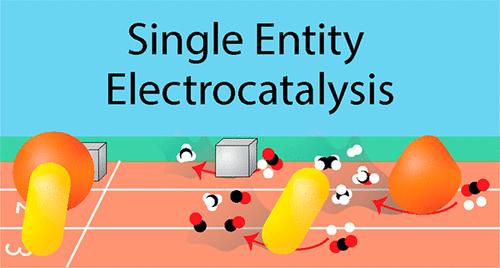当前位置:
X-MOL 学术
›
Chem. Rev.
›
论文详情
Our official English website, www.x-mol.net, welcomes your feedback! (Note: you will need to create a separate account there.)
Single Entity Electrocatalysis
Chemical Reviews ( IF 51.4 ) Pub Date : 2024-07-17 , DOI: 10.1021/acs.chemrev.3c00723 Thomas B. Clarke 1 , Lynn E. Krushinski 1 , Kathryn J. Vannoy 1 , Guillermo Colón-Quintana 1 , Kingshuk Roy 1 , Ashutosh Rana 1 , Christophe Renault 2 , Megan L. Hill 1 , Jeffrey E. Dick 1, 3
Chemical Reviews ( IF 51.4 ) Pub Date : 2024-07-17 , DOI: 10.1021/acs.chemrev.3c00723 Thomas B. Clarke 1 , Lynn E. Krushinski 1 , Kathryn J. Vannoy 1 , Guillermo Colón-Quintana 1 , Kingshuk Roy 1 , Ashutosh Rana 1 , Christophe Renault 2 , Megan L. Hill 1 , Jeffrey E. Dick 1, 3
Affiliation

|
Making a measurement over millions of nanoparticles or exposed crystal facets seldom reports on reactivity of a single nanoparticle or facet, which may depart drastically from ensemble measurements. Within the past 30 years, science has moved toward studying the reactivity of single atoms, molecules, and nanoparticles, one at a time. This shift has been fueled by the realization that everything changes at the nanoscale, especially important industrially relevant properties like those important to electrocatalysis. Studying single nanoscale entities, however, is not trivial and has required the development of new measurement tools. This review explores a tale of the clever use of old and new measurement tools to study electrocatalysis at the single entity level. We explore in detail the complex interrelationship between measurement method, electrocatalytic material, and reaction of interest (e.g., carbon dioxide reduction, oxygen reduction, hydrazine oxidation, etc.). We end with our perspective on the future of single entity electrocatalysis with a key focus on what types of measurements present the greatest opportunity for fundamental discovery.
中文翻译:

单一实体电催化
对数百万个纳米颗粒或暴露的晶体面进行测量很少报告单个纳米颗粒或面的反应性,这可能与整体测量大相径庭。在过去的 30 年里,科学已经转向研究单个原子、分子和纳米粒子的反应性,一次一个。这种转变是由于认识到纳米尺度上一切都会发生变化,特别是重要的工业相关特性,例如对电催化很重要的特性,推动了这种转变。然而,研究单个纳米级实体并非易事,需要开发新的测量工具。这篇综述探讨了巧妙使用新旧测量工具在单一实体水平上研究电催化的故事。我们详细探讨了测量方法、电催化材料和感兴趣的反应(例如二氧化碳还原、氧还原、肼氧化等)之间复杂的相互关系。最后,我们对单一实体电催化的未来进行了展望,重点关注哪些类型的测量为基础发现提供了最大的机会。
更新日期:2024-07-17
中文翻译:

单一实体电催化
对数百万个纳米颗粒或暴露的晶体面进行测量很少报告单个纳米颗粒或面的反应性,这可能与整体测量大相径庭。在过去的 30 年里,科学已经转向研究单个原子、分子和纳米粒子的反应性,一次一个。这种转变是由于认识到纳米尺度上一切都会发生变化,特别是重要的工业相关特性,例如对电催化很重要的特性,推动了这种转变。然而,研究单个纳米级实体并非易事,需要开发新的测量工具。这篇综述探讨了巧妙使用新旧测量工具在单一实体水平上研究电催化的故事。我们详细探讨了测量方法、电催化材料和感兴趣的反应(例如二氧化碳还原、氧还原、肼氧化等)之间复杂的相互关系。最后,我们对单一实体电催化的未来进行了展望,重点关注哪些类型的测量为基础发现提供了最大的机会。












































 京公网安备 11010802027423号
京公网安备 11010802027423号